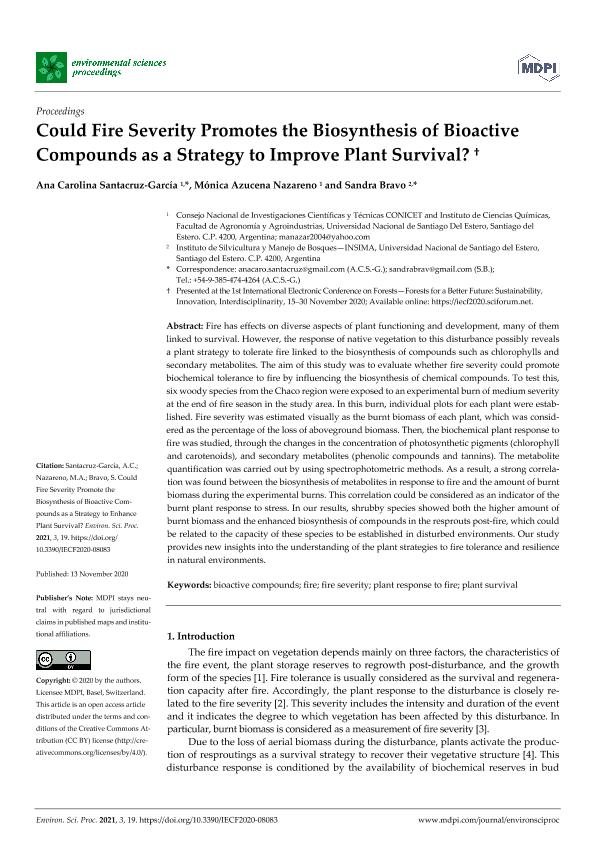Mostrar el registro sencillo del ítem
dc.contributor.author
Santacruz García, Ana Carolina

dc.contributor.author
Nazareno, Mónica Azucena

dc.contributor.author
Bravo, Sandra

dc.date.available
2021-10-26T13:04:47Z
dc.date.issued
2021-11
dc.identifier.citation
Santacruz García, Ana Carolina; Nazareno, Mónica Azucena; Bravo, Sandra; Could Fire Severity Promotes the Biosynthesis of Bioactive Compounds as a Strategy to Improve Plant Survival?; MDPI; Environmental Sciences Proceedings; 3; 1; 11-2021; 1-5
dc.identifier.issn
2673-4931
dc.identifier.uri
http://hdl.handle.net/11336/145045
dc.description.abstract
Fire has effects on diverse aspects of plant functioning and development, many of themlinked to survival. However, the response of native vegetation to this disturbance possibly revealsa plant strategy to tolerate fire linked to the biosynthesis of compounds such as chlorophylls andsecondary metabolites. The aim of this study was to evaluate whether fire severity could promotebiochemical tolerance to fire by influencing the biosynthesis of chemical compounds. To test this,six woody species from the Chaco region were exposed to an experimental burn of medium severityat the end of fire season in the study area. In this burn, individual plots for each plant were established. Fire severity was estimated visually as the burnt biomass of each plant, which was considered as the percentage of the loss of aboveground biomass. Then, the biochemical plant response tofire was studied, through the changes in the concentration of photosynthetic pigments (chlorophylland carotenoids), and secondary metabolites (phenolic compounds and tannins). The metabolitequantification was carried out by using spectrophotometric methods. As a result, a strong correlation was found between the biosynthesis of metabolites in response to fire and the amount of burntbiomass during the experimental burns. This correlation could be considered as an indicator of theburnt plant response to stress. In our results, shrubby species showed both the higher amount ofburnt biomass and the enhanced biosynthesis of compounds in the resprouts post-fire, which couldbe related to the capacity of these species to be established in disturbed environments. Our studyprovides new insights into the understanding of the plant strategies to fire tolerance and resiliencein natural environments
dc.format
application/pdf
dc.language.iso
eng
dc.publisher
MDPI
dc.rights
info:eu-repo/semantics/openAccess
dc.rights.uri
https://creativecommons.org/licenses/by-nc-sa/2.5/ar/
dc.subject
bioactive compounds
dc.subject
fire
dc.subject
fire severity
dc.subject
plant response to fire
dc.subject.classification
Silvicultura

dc.subject.classification
Agricultura, Silvicultura y Pesca

dc.subject.classification
CIENCIAS AGRÍCOLAS

dc.subject.classification
Química Orgánica

dc.subject.classification
Ciencias Químicas

dc.subject.classification
CIENCIAS NATURALES Y EXACTAS

dc.title
Could Fire Severity Promotes the Biosynthesis of Bioactive Compounds as a Strategy to Improve Plant Survival?
dc.type
info:eu-repo/semantics/article
dc.type
info:ar-repo/semantics/artículo
dc.type
info:eu-repo/semantics/publishedVersion
dc.date.updated
2021-07-26T15:14:13Z
dc.journal.volume
3
dc.journal.number
1
dc.journal.pagination
1-5
dc.journal.pais
Suiza

dc.journal.ciudad
Basel
dc.description.fil
Fil: Santacruz García, Ana Carolina. Universidad Nacional de Santiago del Estero. Facultad de Agronomía y Agroindustrias. Instituto de Ciencias Químicas; Argentina. Consejo Nacional de Investigaciones Científicas y Técnicas. Centro Científico Tecnológico Conicet - Tucumán; Argentina
dc.description.fil
Fil: Nazareno, Mónica Azucena. Universidad Nacional de Santiago del Estero. Facultad de Agronomía y Agroindustrias. Instituto de Ciencias Químicas; Argentina. Consejo Nacional de Investigaciones Científicas y Técnicas. Centro Científico Tecnológico Conicet - Tucumán; Argentina
dc.description.fil
Fil: Bravo, Sandra. Universidad Nacional de Santiago del Estero. Facultad de Ciencias Forestales. Instituto de Silvicultura y Manejo de Bosques; Argentina
dc.journal.title
Environmental Sciences Proceedings
dc.relation.alternativeid
info:eu-repo/semantics/altIdentifier/url/https://www.mdpi.com/2673-4931/3/1/19/pdf
dc.relation.alternativeid
info:eu-repo/semantics/altIdentifier/doi/https://doi.org/10.3390/IECF2020-08083
Archivos asociados
